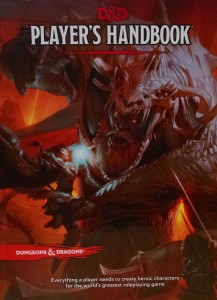Dungeons & Dragons 5th Edition – First Impressions
Welcome – I am proud to announce that this review of the 5th edition Dungeons & Dragons Player’s Handbook is the 750th post on Claw / Claw / Bite!
In addition this is the inaugural post on the new blog and website. The server hosting this blog went down a few months ago. Due to incomplete backups we have had to rebuild a several years of the blog one post at a time. This has only been possible due to the Internet Archive‘s captures of the original blog. Thank you, Internet Archive, you were my only hope. With the help of those captures the many years of our creative works are once again available to the public.
To introduce myself – I’ve been playing Dungeons & Dragons since 1982 or so, and I’ve been publishing material for role-playing games through Unicorn Rampant since 2006. You can see the fruits of our labors here. Feel free to leave comments here on the blog, and expect this new site to continue to evolve and change as we clean up from the move and reconstruction.
I’ve been reading the 5th Edition Dungeons & Dragons Player’s Handbook from cover to cover in preparation for playing and writing material for the new rules. As someone who has already played more than 5 different versions of this game, along with many other role-playing games, I’m very interested in how well this new edition of gaming books are written, and how fun the game looks to play.
My summary? The new edition of the Player’s Handbook is well done, both for new players and those of use who have been loving this hobby for a long time. A few of the best ideas from 4th edition have been baked into a streamlined, inspiring, familiar-feeling new edition of Dungeons & Dragons. Clear, evocative writing illuminates character options and rules throughout, with a healthy dose of illustrative art, and fun tables and charts.
Reviewing the table of contents, I’m glad to report that they have more or less kept the same order of chapters that has been in use since the AD&D Player’s Handbook. The 5e D&D PHB has that same sensible old order of topics that make it a quick and easy-to-use resource for a veteran player like me: Characters, Equipment, Rules, Spells, and Appendices. There is also an extensive index.
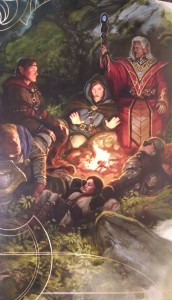 The Player’s Handbook is graced throughout with a generous amount of varied art. Realistic-looking pieces gaze across the page at more illustrative ones, and everything is vividly colorful and well executed.
The Player’s Handbook is graced throughout with a generous amount of varied art. Realistic-looking pieces gaze across the page at more illustrative ones, and everything is vividly colorful and well executed.
The introduction lends good context to what this strange game is, with evocative cues for the imagination throughout. For new players this section of a role-playing game rule book is hugely important – not just to summarize how the game is played but to give the reader an idea as to why it is played. If a prospective player reads the fist page and it doesn’t make sense, or if it just falls flat, then that reader might miss out on this incredible game.
The worlds of Dungeons & Dragons are presented as individual creations with similarities, and the official settings of Greyhawk, The Forgotten Realms, and Dragonlance are used for examples throughout. Thus the reader is presented with a rich variety of inspirational details while being encouraged to create their own unique game.
The character creation section does a good job of walking the player step-by-step through the process of filling out the character sheet. The basics of what makes up a character and relevant rules are explained as needed along the way. I applaud the tutorial-style approach to the overview.
The races presented are divided into common and uncommon races, the former being the humans, halflings, elves and dwarves we’re familiar with from Tolkien’s Middle Earth. Personally, I find it jives nicely with my mental image of a fantasy world, wherein the included dragonborn, gnomes, half-elves, half-orcs and tieflings are presented as being less prevalent. Of course an individual Dungeon Master could write whatever mix of races they wanted into their own campaign, changing things to suit their group’s tastes, but that goes for everything in these books. There are a wealth of explanatory sidebars filled with in-game role-playing details about how the various races relate to each other in this typical fantasy world. In an example of how this edition has streamlined the rules Darkvision has been simplified – they combined what previous editions have called low-light vision and darkvision and gave it to everyone except humans, halflings, and dragonborn.
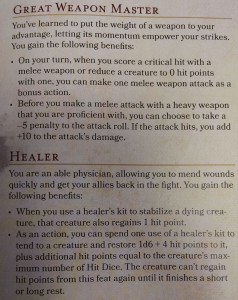 The classes received a similar treatment – there are lots of well-written inspirational passages that give a variety of ideas about what each different class can be. Class abilities have been both expanded and streamlined. For example there are now five different fighting styles, and rangers, fighters, and paladins get to chose from different subsets of the five. For the magically inclined classes spellcasting has also been simplified and made more flexible while retaining the core feel for each class. Also, some of the most popular prestige classes have been written into the core classes as options that can be chosen as the character progresses to higher levels. The cherry on top is the inclusion of the warlock class as one of the core classes. Recognizable feats have been combined and made more fun – the cleave and power attack feat takes effect on rolls of natural 20, for example. Other rules have similar dramatic effects when a 1 or a 20 is rolled.
The classes received a similar treatment – there are lots of well-written inspirational passages that give a variety of ideas about what each different class can be. Class abilities have been both expanded and streamlined. For example there are now five different fighting styles, and rangers, fighters, and paladins get to chose from different subsets of the five. For the magically inclined classes spellcasting has also been simplified and made more flexible while retaining the core feel for each class. Also, some of the most popular prestige classes have been written into the core classes as options that can be chosen as the character progresses to higher levels. The cherry on top is the inclusion of the warlock class as one of the core classes. Recognizable feats have been combined and made more fun – the cleave and power attack feat takes effect on rolls of natural 20, for example. Other rules have similar dramatic effects when a 1 or a 20 is rolled.
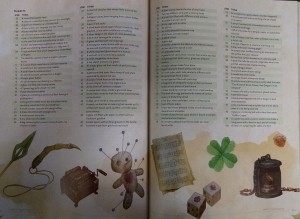 Throughout the book there are great tables and charts. Finding the trinkets chart, for example, just thrilled me. What a great resource to inspire players and DMs! And there are nods there, as well as through the rest of the book, to great classic D&D adventures and supplements I’ve played with such as The Temple of Elemental Evil. When looking for inspiration, trying to create your first dungeon, or just rolling random encounters and treasure, a evocative table to roll or pick from is a great tool. I’m glad they included lots of them.
Throughout the book there are great tables and charts. Finding the trinkets chart, for example, just thrilled me. What a great resource to inspire players and DMs! And there are nods there, as well as through the rest of the book, to great classic D&D adventures and supplements I’ve played with such as The Temple of Elemental Evil. When looking for inspiration, trying to create your first dungeon, or just rolling random encounters and treasure, a evocative table to roll or pick from is a great tool. I’m glad they included lots of them.
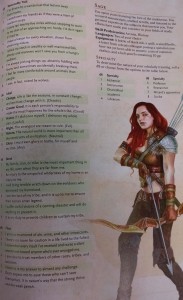 The excellent writing continues in the character details chapter, which covers description, values, bonds, flaws, alignment, backgrounds, feats, and inspiration. The backgrounds feature is a great innovation – players pick one of the many backgrounds, such as folk hero, noble, or acolyte, and that background confers skill and tool proficiency along with other character features. Each background has plenty of example prompts to inspire some creative storytelling for your character. It’s a huge improvement, in terms of player experience, over the skill point system which was always one of the most tedious parts of character creation in my opinion. Now players can just pick one background that confers a group of related skills and be done with it. Since your choice is not tied to your class players get to have a bit more variety in their characters. For those who prefer to craft something individual and different there are rules for that as well.
The excellent writing continues in the character details chapter, which covers description, values, bonds, flaws, alignment, backgrounds, feats, and inspiration. The backgrounds feature is a great innovation – players pick one of the many backgrounds, such as folk hero, noble, or acolyte, and that background confers skill and tool proficiency along with other character features. Each background has plenty of example prompts to inspire some creative storytelling for your character. It’s a huge improvement, in terms of player experience, over the skill point system which was always one of the most tedious parts of character creation in my opinion. Now players can just pick one background that confers a group of related skills and be done with it. Since your choice is not tied to your class players get to have a bit more variety in their characters. For those who prefer to craft something individual and different there are rules for that as well.
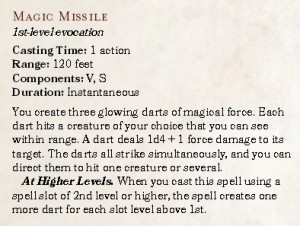 The magic section includes all the expected spells, and some new ones from 4th edition. The spells are simple and clear, most a few short paragraphs long, and the mechanics for increasing the power of lower-level spells are great. Using a higher level spell slot boosts the power of most spells in a nice, linear way. Spellcasting classes have 0th level cantrips they can cast an unlimited number of times, but because the hit point and damage totals are lower than they were in 4th edition, players shouldn’t have to actually cast them an unlimited number of times any more (sorry, 4th edition. That’ll be the only joke I make about you). Even spells that have been tricky or confusing to some in previous editions , such as Dispel Magic, have been streamlined and given more flexibility. Spells are one of the most important aspects of Dungeons & Dragons and the authors have done a great job with them.
The magic section includes all the expected spells, and some new ones from 4th edition. The spells are simple and clear, most a few short paragraphs long, and the mechanics for increasing the power of lower-level spells are great. Using a higher level spell slot boosts the power of most spells in a nice, linear way. Spellcasting classes have 0th level cantrips they can cast an unlimited number of times, but because the hit point and damage totals are lower than they were in 4th edition, players shouldn’t have to actually cast them an unlimited number of times any more (sorry, 4th edition. That’ll be the only joke I make about you). Even spells that have been tricky or confusing to some in previous editions , such as Dispel Magic, have been streamlined and given more flexibility. Spells are one of the most important aspects of Dungeons & Dragons and the authors have done a great job with them.
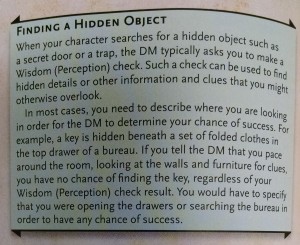 In an admirable move, Wizards of the Coast has released the basic rules for free as a PDF. It includes rules for playing a human, dwarf, elf or halfling and cleric, fighter, rogue and wizard, and about as many spells as were in the AD&D PHB. http://dnd.wizards.com/articles/features/basicrules?x=dnd/basicrules
In an admirable move, Wizards of the Coast has released the basic rules for free as a PDF. It includes rules for playing a human, dwarf, elf or halfling and cleric, fighter, rogue and wizard, and about as many spells as were in the AD&D PHB. http://dnd.wizards.com/articles/features/basicrules?x=dnd/basicrules
In conclusion I will say that I’m really looking forward to giving this new set of rules a spin. The writers at Wizards of the Coast have produced a new edition of the game that looks to have gotten the rules out of the way so that we can focus on the exciting stories we’re trying to tell. Keep watching this spot on Claw / Claw / Bite for more impressions as we play.
Posted in 5th edition Dungeons & Dragons, Editorial, Review and tagged Fantasy by Adam A. Thompson with 2 comments.
Finkald’s Freebooters
medium level fantasy encounter
While travelling on the road, the Player Characters (PCs) encounter “Finkald’s (‘Fin-kald) Freebooters”, a small army composed of rowdy dwarven mercenary veterans. They are fresh from a string of victories in the lands to the west, and are on a quest to find the fabulous lost dwarven stronghold of Kargoth. Finkald claims to have a map that shows the way to Kargoth, also known as “The Invisible Fortress”, but will show it to none, saying he has committed it to memory. His secret, which he will never admit, is that he recently learned that his victories in the east had led to his being singled out for assassination by the wild priest-hunters of the elven lands they had been raiding. He is therefore leading his warband as far away as he can get from those woods.
Upon meeting the party, Finkald will size them up, silently appraising their wealth, asking which way the roads lead, if they know anything of Kargoth, and who the players are and where they are headed. While Finkald talks the dwarves will fall out of order to begin drinking from a keg on a wagon and eating from a haunch of roast deer. Some will gather to hear the conversation.
Unless the players flee or offer to join Finkald on his journey to Kargoth he will ask them if they can help the army with any spare provisions they may have – “You see how hungry my Freebooters are – full bellies keep them happy!”. If the players seem wealthy and relatively weak, he might ask for gold or, particularly, any gems or jewelry they players are wearing. If the players refuse to give him what he asks for, he raises his voice and makes threats, “What’s to stop us from taking it, and everything else you have!?” Unless the players pay his price or run away, they try to take the players’ valuables by force.
ENCOUNTER – low to medium level
- Fainkald – dwarven ranger 6
- Seargents – 3 x dwarven fighter 4
- Freebooters – 20 x dwarven fighter 1
Posted in Encounter, rules agnostic and tagged Fantasy by Adam A. Thompson with no comments yet.
Room 7: Athganazar’s Laboratory
This area is a separate level that can only be accessed by the methods described in Room 6: The Crucible.
As the arcane mist dissipates, you appear in what looks to be an ancient laboratory which while dusty and archaic, has seen recent use. Tables along the walls and shelves set into alcoves in the walls are filled with various alchemical apparatus, half-completed mixtures and parchment. In the center of the room is a stone bier upon which rests a body draped in silken robes. A cracked flask with what remains of a dark, viscous liquid is on the floor nest to the body.
Athganazar is not actually dead but is instead a Proto-lich who has so far failed in the attempts to achieve the full undead status and abilities he desires.
This laboratory is where Athganazar’s soul has been awaiting new bodies to possess and attempt to finish his transformation into a lich. His dead body is what is lying upon the bier while his soul has moved into his phylactery (a plain seeming stone jar upon the top shelf along one wall of the room. It will appear as magical to detect magic, despite its otherwise plainness. The jar is tiny and has 40 hit points, hardness 20, and a break DC of 40) from which he will attempt to possess (via magic jar spell) the character that has seemed the most resourceful in solving the challenges up to this point.
His plan is possess one of the players and attempt to have them drink the remains of the liquid in the flask to attempt to create a new lich body for himself. If he succeeds then he will go ahead and kill the party.
Failing that, he will attempt to kill as many characters as possible, leaving the possessed body if it is slain to return to the jar and to possess another, continuing this until there is only one character left. When only one remains, he intends to possess that body and to use it to make another attempt at successful lich creation.
To defeat him, the party will need to locate and destroy the phylactery (thus leaving him no avenue of egress) and to either kill the character which he has currently possess of to find a way to otherwise force him to leave that body. If forced to leave or the possessed body slain after the phylactery is destroyed, (and there is no active Proto-Lich body ready for him) Athganazar will be destroyed.
The flask of dark liquid in the flask is the remains of the lich creation potion that Athganazar drank which killed his body but left it in a state of perfect preservation. If a PC tastes the dark liquid then they must save or die (Con DC 30). If they succeed they then take 20 pts of damage. If they fail their body becomes a new, empty proto-lich ready for Athganazar to possess. Likewise, if they spill or apply the liquid to the body lying upon the bier then that body will also become a revitalized proto-lich vessel suitable for possession as well.
Posted in 3rd edition Dungeons & Dragons / d20 fantasy / Pathfinder, Encounter, Magic Item and tagged Fantasy, The Tomb of Athganazar by Stephen Hilderbrand with no comments yet.
Room 6: The Crucible
The Word “Crucible” is carved above the doorway into this room. In the room, a large fire elemental is seemingly contained by the magic circle upon the floor. Between you and the elemental is a large marble bowl set upon a stone base.
DM Notes: The bowl is literally the crucible needed to re-forge the broken key. For this challenge the party will need to place all four of the key fragments into the bowl and then free the elemental and lure it into engulfing the crucible. Once that happens the elemental will be consumed and the key will be restored. All four fragments must be in the bowl for this to work. Any less and nothing happens.
If the elemental is instead slain by the party it will reappear in the circle one round later (and the circle will be restored of any damage it may have taken as well) effectively resetting the encounter.
Once the key has been re-forged, a keyhole will appear in the north wall of this room. Once the key is placed into the keyhole and turned, the tumblers will wail and the party will be teleported to the actual “tomb” of Athganazar. If lured into the crucible:
The elemental lumbers into the crucible, arms surrounding the rim, legs dropping into the heap of keys. Its eyes stretch downward as if tears and its gaping maw crackles with embers. A fiery blaze fills the crucible, the elemental disappearing among the smokeless flames. Suddenly, the warm light of the fire is extinguished. Among the ashes you see an ivory key.
Once the key is lifted from the ashes, they will notice that the head of the key is carved into the head of a skeleton:
As you turn the key over in your hand, you note that the skeletal head of the key has reflective eyesockets, iron fangs, and a crown inset with six prismatic gems – ruby, topaz, sunstone, emerald, sapphire, amethyst. Iron fang-like prongs jut out into the darkness at jagged angles.
Once the key is inserted and turned:
The eyes of the key ignite in a bright burst as the floor swirls into a rainbow portal. You fall in.
Posted in 3rd edition Dungeons & Dragons / d20 fantasy / Pathfinder, Encounter and tagged Fantasy, The Tomb of Athganazar by Stephen Hilderbrand with no comments yet.
Adventure Backdrop: Deep Roads
I’ve been playing a lot of the computer game Dragon Age: Origins recently and I’ve really enjoyed the great writing of the game: they really put together a deep and interesting history for the game’s setting. One of the elements of this history keeps inspiring me with adventure ideas and encounters every time I think about it: The Deep Roads.
In the game’s history the dwarven people once had a vast underground empire. The cities of this empire were connected by a massive series of tunnels that the dwarves had dug and that spanned hundreds of miles underground.
This idea, a series of underground highways, just keeps inspiring me as a DM. What heroic adventures must have been undertaken as those roads were first carved? What difficulties must have faced those undertaking the creation of such an ambitious work? What troubles and opportunities did the Deep Roads create during the heyday of the dwarven empire? And after the empire’s fall, when the deep roads were lost to them, taken over by horrors from below, what opportunities for adventure do they present? Who could resist the lure of the lost treasures of a dwarven empire? What needful items might be lost down their dark and crumbling avenues?
In the coming days I will be posting some encounters, creatures, and adventure seeds that take place against this inspiring backdrop. For today, I refer you to one of the creatures that slithers along the dark passages of the underdark: the Crawling Drake.
Crawling Drake
This creature’s common name is something of a misnomer, as this dragon-like creature has no legs, just a scaly, sinuous, serpentine body and a pair of muscular wings. Able to rise and strike by propping itself up with its wings, these drakes deliver vicious wounds with their snapping jaws.
The origin of their species is speculated to be a mixture of dark things of the underlands, such as a corruption of fang dragon touched by creatures from the outer realms of cruelty and madness. Able to speak a few words of broken draconic and undercommon, crawling drakes are not especially intelligent, but they are tremendously fearsome, nasty and cruel.
Crawling drakes are crafty combatants and adept stalkers, and so will ambush their prey when possible. Once they pick a target, they will attempt to crush them in their coils while delivering bite after bite. If possible they will attack the weakest-looking member of a group first.
Presented below is the wyrmling version of this monstrosity, as it is encountered while still young and relatively small.
Wyrmling Crawling Drake Level 5 Elite Lurker
Medium Aberrant Magical Beast (Reptile)- XP 400
Initiative +11 Senses Perception +9
HP 96; Bloodied 48
AC 19 Fortitude 17, Reflex 18, Will 16
Vulnerable 5 poison
Saving Throws +2
Speed 4, fly 8
Action Points 1
Powers
Venomus Bite – At-Will, Standard Action, Poison
+10 vs AC, 1d10 + 4 damage, the target is grabbed, and make a secondary attack:
Secondary Attack – Venom
+8 vs Fortitude, 1d6 + 4 posion damage and ongoing 5 poison damage (Save Ends).
Crushing Coils – At-Will, Minor Action
Target must be grabbed
+8 vs Fortitude, 3d8 + 4 damage and the target is weakened until the end of its next turn.
Hypnotic Coils – Immediate Interrupt when Attacked, One target within close blast 5, Recharge 4-6
As you prepare to strike the loathsome beast, its moving coils cause a sudden disorienting vertigo.
+6 vs Will, the target is dazed (save ends) and takes -4 on the triggering attack’s to-hit roll.
Alignment Evil – Languages some Undercommon, Draconic
Skills Perception +9, Stealth +12
Str 18 (+6) Dex 21 (+7) Wis 15 (+4)
Con 12 (+3) Int 9 (+1) Cha 9 (+1)
A character knows the following about crawling drakes with the following Dungeoneering skill checks:
DC 15: These large aberrant reptiles, called Crawling Drakes by the dwarves, are dangerous hunters of the caverns below the surface.
DC 20: Crawling Drakes use a venomous bite and their crushing coils to kill their prey, and have strangely hypnotic power over men’s minds.
DC 25: Ironically, though venomous, Crawling Drakes are themselves particularly susceptible to poison.
Posted in Uncategorized and tagged creature origin: far realms, creature type: magical beast, creature: heroic lurker, Fantasy by Adam A. Thompson with no comments yet.
